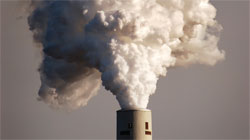Today, UCS unveiled a proposal to strengthen a laudable but modest U.S. EPA rule to cut carbon dioxide emissions from our nation’s power plants by increasing renewable energy use.
We make this proposal because of the urgent need to dramatically lower the emissions of this heat trapping gas, and because power plants are 40 percent of the problem and offer the most cost-effective option we have to cut carbon. Implementing our approach to expand the role of renewable energy could increase total power sector carbon reductions under the rule to nearly 40 percent below 2005 levels by 2030, or 220 million metric tons more reduction than proposed by the EPA.
Background
This post is part of a series on the EPA Clean Power Plan.
In June, the EPA issued a draft rule that requires power plants to cut carbon dioxide emissions by approximately 30% from 2005 levels by 2030. While at first glance a 30% cut seems strong, emissions were already 15% below 2005 levels in 2013, so the rule cuts only another 15% over the next 15 years. This contribution from the power sector to economy-wide reductions is far lower than the world’s best climate scientists have determined is needed to stave off the worst effects of global warming. And it does not arm President Obama with the best tools to pledge an ambitious greenhouse gas goal that other countries can emulate during the crucial international climate change negotiations next year.
A primary reason why the rule is limited is that it greatly underestimates just how successful renewable energy has been, and can be, in displacing coal and gas-fired power plants. The cost of wind and solar energy has dropped by close to 60% in the last five years, and these sources are growing exponentially—wind by 75%, solar by 473%. Wind energy in the “wind belt” of the Great Plains, and large solar installations in the southwest, are now competitive with fossil-fueled power. As the renewable build-out continues, it’s a safe bet that costs will continue to drop due to technological innovation and economies of scale.
Rather than take advantage of this success and use it to raise the bar higher, the EPA rule is largely “bearish” on the prospect for more renewable energy. The EPA assumes that even with this rule in place in 2020, renewables will be 7% of the power supply, which is lower than the official estimate by the Energy Information Administration (EIA) of 9% in a “business as usual case”, i.e., with no rule at all. And in 2030, the EPA’s renewable generation targets for seven states are lower than those states are doing now, and lower than seventeen states are required to do under their own laws.
UCS’s Proposal
UCS’s proposal is both more ambitious and more realistic. We raise the 2030 target that the EPA has proposed for renewables—from 12% to 23%, based primarily on two key variables: what states have already achieved over the last five years, and what states have committed to do in legally binding laws known as renewable portfolio standards.
 This will likely drive some already highly performing states to generate a lot more renewable energy, such as Iowa , Texas, and South Dakota (wind) and Arizona, New Jersey, and North Carolina (solar). For states that are lagging behind, this will drive them to meet a national minimum growth rate of one percent of electricity demand per year from renewables. And while every state has sufficient renewable energy potential to meet these targets, they can lower the cost of compliance by buying the renewable power from states with strong renewable resources.
This will likely drive some already highly performing states to generate a lot more renewable energy, such as Iowa , Texas, and South Dakota (wind) and Arizona, New Jersey, and North Carolina (solar). For states that are lagging behind, this will drive them to meet a national minimum growth rate of one percent of electricity demand per year from renewables. And while every state has sufficient renewable energy potential to meet these targets, they can lower the cost of compliance by buying the renewable power from states with strong renewable resources.
And the cost? We estimate, using state-of-the-art, well-accepted energy models, that this proposal will add no more than eighteen cents per month to the electric bill of the average residential customer. Why is the cost so low? Because of the continued drop in the cost of renewable power, and because the more renewable energy that is put into the grid, the lower the price of natural gas, which typically determines the “market clearing” price of electricity. Lower natural gas prices also means lower natural gas bills for heating homes and manufacturing.
For more on the UCS proposal, see EPA Clean Power Plan Underestimates Power of Renewable Energy to Reduce Carbon Emissions by Steve Clemmer, UCS director of energy research.
Next Steps
Our goal is for the EPA to raise the level of ambition of its rule by taking full advantage of renewable energy. Other strategies such as increasing energy efficiency in homes and businesses could take us even further. The EPA is taking public comment on this rule until December 1 and is expected to issue a final rule by June 2015.
We are sharing our proposal and drumming up support with our allies nationwide, and I urge you to let the EPA know you back raising the standard and cutting more carbon pollution. Our message is simple—we must do better, and we can do better!

